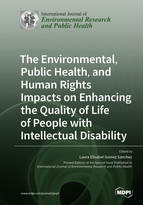The Environmental, Public Health, and Human Rights Impacts on Enhancing the Quality of Life of People with Intellectual Disability
A special issue of International Journal of Environmental Research and Public Health (ISSN 1660-4601).
Deadline for manuscript submissions: closed (31 December 2020) | Viewed by 54459
Special Issue Editor
Special Issue Information
Dear Colleagues,
We are arranging a Special Issue entitled “The Environmental, Public Health, and Human Rights Impacts on Enhancing the Quality of Life of People with Intellectual Disability”, which will be published in the International Journal of Environmental Research and Public Health, a multidisciplinary open access journal by MDPI with extraordinary visibility, fast peer review/publication process, and high impact factor (JCR 2018 IF=2.468; Q1 in ‘Public, Environmental & Occupational Health’ [SSCI]).
Societal views on the human rights of persons with disabilities have significantly changed over the last four decades. However, while achieving equality, autonomy, nondiscrimination, participation, and inclusion should be a priority, abuses and violations of rights often occur in the most immediate environments of people with intellectual disability. We would like to invite researchers to contribute innovative work to be considered for publication in this Special Issue, intended to provide greater visibility to people with intellectual disability as full subjects of rights and improve their quality of life from a perspective of human rights, citizenship, and contextual analysis.
This Special Issue is intended to discuss the role of context, the provision of inclusive environments, and the improved health status and quality of life of people with intellectual disability. Therefore, we call for manuscripts addressed at promoting quality of life-related personal outcomes and enhancing quality of life and equality for people with intellectual disability. Potential topics include but are not limited to research on rehabilitation, health (physical, social, and emotional), education, employment, inclusion, supports, leisure, and other personal (e.g., age, gender, intellectual functioning, adaptive behavior, diagnostic group) or environmental variables (normative expectations, attitudes, opportunities, accessibility, type of services, culture, rights). The keywords listed below provide an outline of some of the possible areas of interest.
Original, high-quality contributions from all over the world that have not yet been published or that are not currently under consideration for publication by other journals are welcomed. Submissions can include original research articles, systematic reviews, meta-analyses, and theoretical contributions. Priority will be given to papers presenting the results of data collection and statistical analysis, as well as theoretical reviews framed within a systematic methodology or meta-analysis, which are outstanding because of the relevance of their results. We also encourage study findings that can be translated to policy or practice suggestions, and thus, research that can be applied to improving quality of life of people with intellectual disability.
All manuscripts must be received no later than end of August 2020. All submitted manuscripts will be reviewed by experts in the intellectual disability field and will be processed through a fast peer review process.
Dr. Laura Elisabet Gomez Sanchez
Guest Editor
Manuscript Submission Information
Manuscripts should be submitted online at www.mdpi.com by registering and logging in to this website. Once you are registered, click here to go to the submission form. Manuscripts can be submitted until the deadline. All submissions that pass pre-check are peer-reviewed. Accepted papers will be published continuously in the journal (as soon as accepted) and will be listed together on the special issue website. Research articles, review articles as well as short communications are invited. For planned papers, a title and short abstract (about 100 words) can be sent to the Editorial Office for announcement on this website.
Submitted manuscripts should not have been published previously, nor be under consideration for publication elsewhere (except conference proceedings papers). All manuscripts are thoroughly refereed through a single-blind peer-review process. A guide for authors and other relevant information for submission of manuscripts is available on the Instructions for Authors page. International Journal of Environmental Research and Public Health is an international peer-reviewed open access monthly journal published by MDPI.
Please visit the Instructions for Authors page before submitting a manuscript. The Article Processing Charge (APC) for publication in this open access journal is 2500 CHF (Swiss Francs). Submitted papers should be well formatted and use good English. Authors may use MDPI's English editing service prior to publication or during author revisions.
Keywords
- intellectual disability
- quality of life
- valued outcomes
- convention on the rights of persons with disabilities
- contextual analysis
- context-based interventions
- supports paradigm
- healthcare and social services
- inclusion
- empowerment
- self-determination
- accessibility
- abuse






